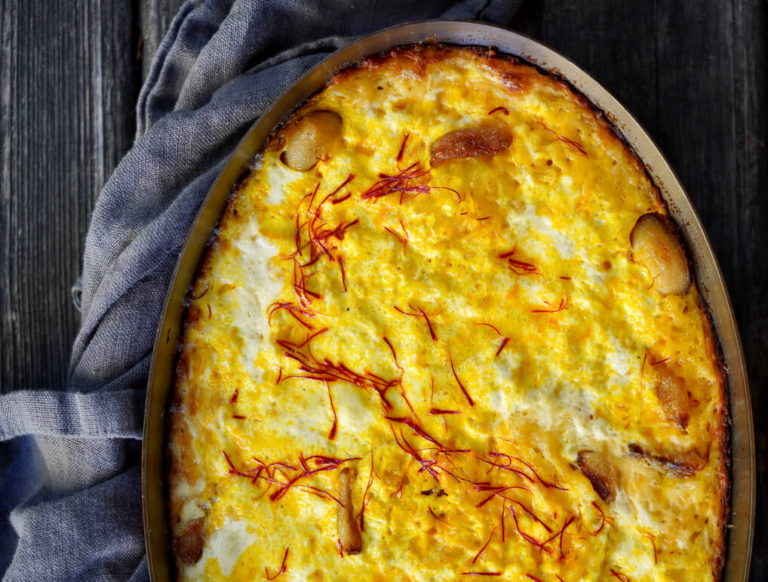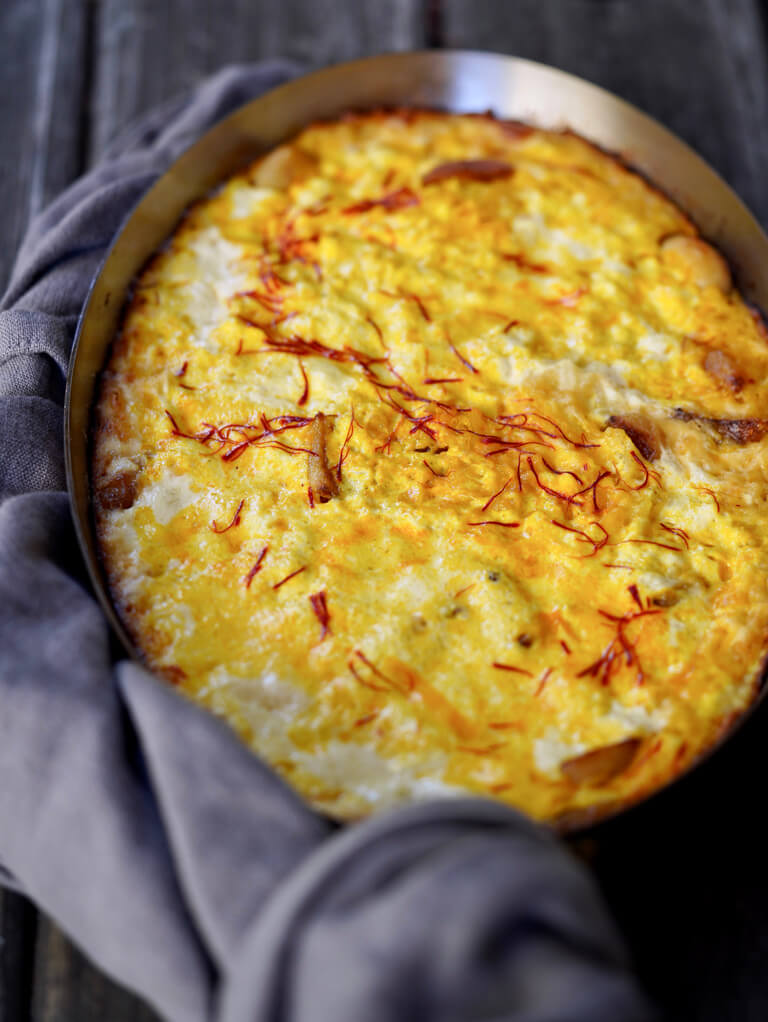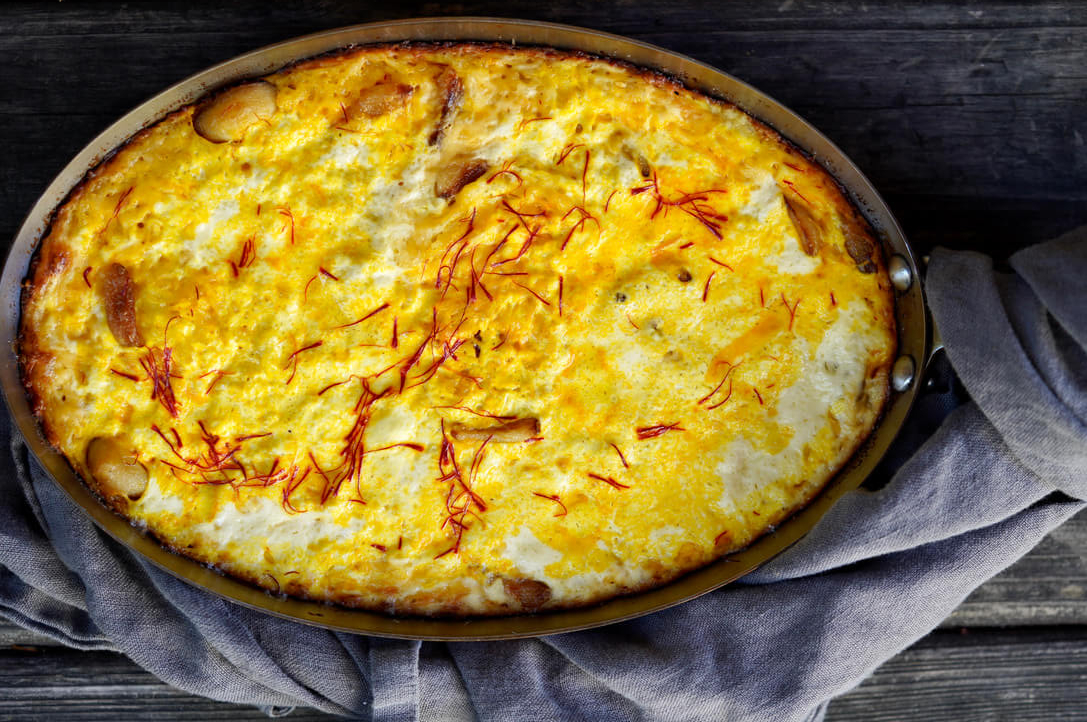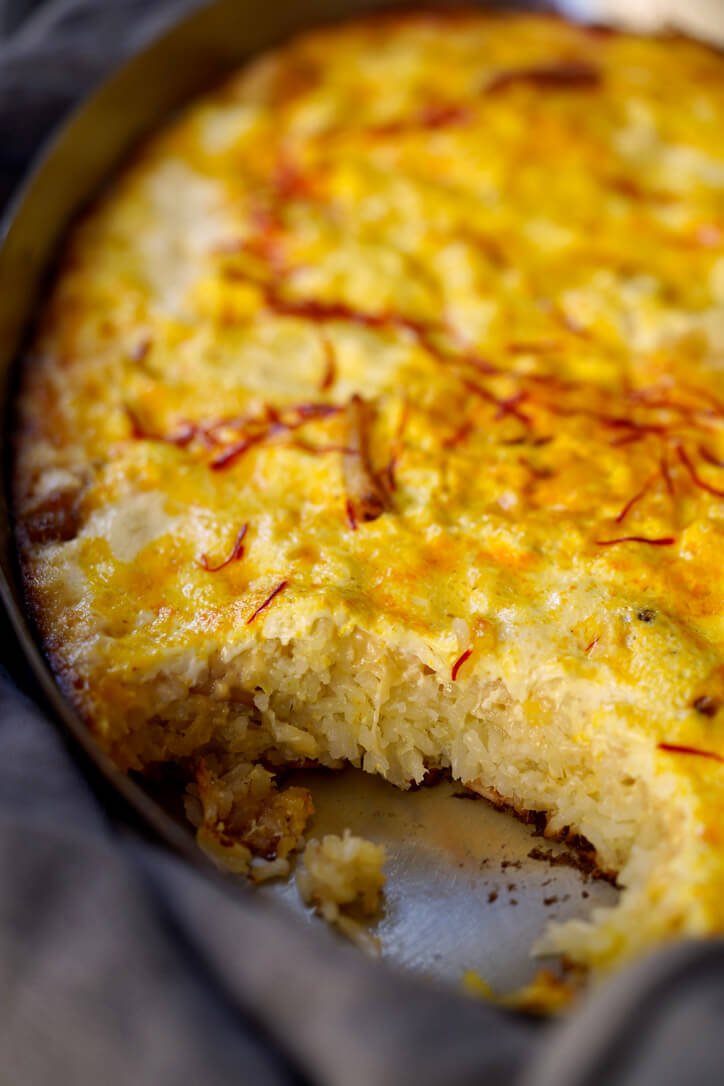Baked Rice

This cheesy baked rice is a new comfort dish I can’t seem to get enough of. I once read that a cheesy baked dish was like a fluffy down comforter: you just want to slide in and pull it up over your head. I think that sums this dish up rather well. This is the perfect side for just about anything you can think of. From short ribs to crispy breaded chicken, this baked rice is mild enough to work with most proteins with just enough pizzaz to make it memorable.
The History of Rice
Rice, has a long history and one I’m fascinated by. Roughly one-half of the world population, including virtually all of East and Southeast Asia, is wholly dependent upon rice as a staple food. Roughly 95% of the world’s rice crop is eaten by humans. Rice has fed more people over a longer period than any other crop in existence.
As far back as 2500 B.C. rice has been documented in the history books as a source of food and tradition. Beginning in China and the surrounding areas, its cultivation spread throughout Sri Lanka, and India. Later, it was then passed onto Greece and the Mediterranean. From there, rice spread throughout Southern Europe and to parts of North Africa. And it was from Europe rice made its way to the New World. From Portugal, it was brought into Brazil and from Spain to Central and South America. Rice could be taken to many parts of the world due to its versatility. It can grow in the desert conditions of Saudi Arabia, in addition to the wetland deltas of Southeast Asia in the flooded rice plains which we are most familiar with.
A Breakdown of Rice
Rice is one of the 8 true cereal grains, along with wheat, oats, corn (maize), barley, rye, millet, and sorghum. There a 4 parts to the rice grain: the hull, bran, white rice, and germ.
- Hull: Each grain of rice is enclosed in a tough outer hull or husk, that needs to be removed before it can be consumed. This layer is removed in all rice types.
- Bran: Under the hull, the bran layer is not removed in all rice types. This nutritious whole grain section is usually tan-colored, but it may be reddish or black depending on the pigmentation in the bran layers. The bran layer may be consumed, but it is often removed when further processing rice.
- White Rice: Once the bran and germ layers are removed, white rice remains. Known as the endosperm, this is the part of the rice that is most commonly consumed.
- Germ: Found under the hull, the germ, or rice kernel, is nutrient-dense. Full of B vitamins, minerals, and proteins, it helps give rice its color and added nutritional benefits.
Cultivation
Many cultures have evidence of early rice cultivation, including China, India, and the civilizations of Southeast Asia. The earliest archaeological evidence comes from central and eastern China and dates to 7000–5000 BCE. More than 90 percent of the world’s rice is grown in Asia, principally in China, India, Indonesia, and Bangladesh, with smaller amounts grown in Japan, Pakistan, and various Southeast Asia. Rice is also cultivated in parts of Europe, North and South America, and Australia.
The cultivated rice plant is an annual grass that grows to about 4 feet in height. The leaves are long and flat and are borne on hollow stems. The fibrous root system is often broad and spreading. The flower cluster is made up of spikelets bearing flowers that produce the fruit, or grain.
Except the type called upland rice, the plant itself is grown on submerged land in the coastal plains, tidal deltas, and river basins of tropical, semitropical, and temperate regions. The seeds are sown in prepared beds, and when the seedlings are 25 to 50 days old, they are transplanted to a field, or paddy, which has been enclosed by levees and submerged in 2-4 inches of water.
The seeds remain submerged during the growing season. In hilly areas, rice farms are commonly terraced to keep the paddies flooded at various elevations. Successful rice production depends on adequate irrigation. Long periods of sunshine are critical. Rice yields vary considerably, about 600-3,500 pounds per acre. Like sunshine, adequate irrigation is essential. Fields must be drained and dried before harvesting.
Processing
The harvested rice kernel, (also known as paddy, or rough, rice), is enclosed by the hull, or husk. Milling typically removes both the hull and bran layers of the kernel, and a coating of glucose and talc is sometimes applied to give the kernel a glossy finish. Rice that is processed to remove only the husks, called brown rice. Rice that is milled to remove the bran as well is called white rice and is greatly diminished in nutrients.
Grain Size
Long-grain rice will have a longer cylindrical shape, whereas short-grain rice will have a shorter and wider shape. Rice is often characterized as one of three varieties – long grain, medium grain, or short grain rice, which refers to the length and shape of the grain. The grain size affects the texture of the rice, therefore long grain, medium grain, and short grain rice are all used for different cooking applications.
- Long grain rice is at least three to four times as long as it is wide. Due to its starch composition, it has a light, fluffy texture and separates when cooked.
- Medium-grain rice is shorter and wider than long-grain rice. It has a chewy, tender, and slightly sticky texture when cooked.
- Short-grain rice is less than twice as long as it is wide. It has a soft, tender, and sticky texture when cooked.
Common Types of Rice + Usages
- Arborio rice is a medium-grain rice that is wider in size and has a characteristic white dot at the center of the grain. It is named after the town of Arborio in the Po Valley of Italy, where it is grown. Due to the high starch content of Arborio rice, it has a slightly chewy and sticky consistency and develops a creamy texture when cooked. Arborio rice is often used for risotto, rice pudding, and soup.
- Basmati rice is a long, dry grain. They add a pleasant, nutty aroma and flavor to any dish. It is common in Indian and Asian cuisine, but it can be used in a variety of flavorful recipes. Basmati rice is often used for making, pilafs, and saffron rice.
- Black rice (also known as forbidden rice), gets its color from anthocyanins, the same antioxidant that’s found in blueberries and blackberries. Black rice has a mildly nutty, earthy flavor. Black rice is often used to make puddings, soup, and rice cakes.
- Bomba rice is a medium grain rice that is cultivated in the Valencia region of Spain. It has a firm texture that lends itself well to Spanish paella, as it needs more liquid to absorb when cooking than other rice varieties.
- Brown rice is a whole grain that has its bran and germ layers still intact, which gives the rice its characteristic tan color. It has a firmer texture with a nuttier, earthier flavor than white rice, and it provides more fiber, vitamins, and minerals per serving. Brown rice can be substituted in any recipe that calls for white rice to increase its nutritional content. Brown rice is often used for stuffing, casseroles, and rice pilafs.
- Jasmine rice is a long grain rice with a lovely nutty and floral aroma. This rice has a soft texture when cooked. Use it when making a variety of traditional Asian dishes, including curries and stir-fry.
- Long-grain white rice is the most common rice used in traditional American recipes, and it’s also popular in Asian and Mexican cuisine. White rice has a mild flavor and a lighter, fluffier texture when cooked. It also takes much less time to cook white rice than brown rice. White rice is often used for stuffing, bowls, casseroles, stir-fry dishes, and rice pilaf.
- Parboiled rice is rice that has been partially boiled in its inedible outer husk. This process improves the texture of the rice, cuts down on cooking time, and saves some of the original vitamins and minerals found in the rice. The flavor is typically mild and nutty. It is technically a cooking method for rice rather than a variety, so it can come in long, medium, and short-grain rice varieties. Parboiled rice is often used for stuffing, casseroles, stir-fries, and rice pilaf
- Sticky rice, also known as glutinous rice or sweet rice, is a long-grain white rice that has a low amylose starch content, which causes the rice to have an extremely sticky texture when steamed. The flavor is typically mild and it’s grown mainly in Southeast and East Asia. Sticky rice is often used for dumplings, desserts, or rice balls.
- Sushi rice is technically short-grain white or brown rice that has a soft, tender, mild flavor and very sticky texture. Sushi rice is made by combining short-grain white or brown rice with sugar, salt, and vinegar. Often short-grain white or brown grain rice will be labeled as “sushi rice” on its packaging to denote that it is ideal for using to roll sushi.
For this baked rice dish I use basmati rice which is a favorite of mine. The nutty aroma is a perfect match for the sweet, floral notes of the saffron. The cheese, half-and-half, and egg help bind the rice creating a soft, creamy texture that is capable of soothing your soul if you embrace it. This new(ish) recipe is one with true staying powder, at least if you ask my family.
Baked Rice
Ingredients:
- 1/2 teaspoon saffron threads, soaked in 2 tablespoons boiling water for 30 minutes
- 1/4 cup Extra Virgin olive oil
- 20 garlic cloves, peeled
- 1 1/4 cups basmati rice
- 1 1/2 teaspoons kosher salt
- 4 ounces medium cheddar cheese, shredded
- 1 3/4 cups half-n-half
- 1 egg yolk
Directions:
- Heat oven to 425 degrees F.
- Put the oil into a 10-inch sauté pan set over medium heat. When the oil shimmers, add the garlic cloves and cook, tossing occasionally, until the garlic is golden brown and soft, about 10 minutes. Allow to cool slightly.
- Mix the half-n-half and the egg yolk until blended and set near your workstation.
- Spread the rice over the garlic in an even layer. Sprinkle the salt over the rice, and then pour the half-n-half and egg mixture over the rice. Sprinkle the shredded cheese on top of the rice. Cover the pan tightly with aluminum foil, place in the oven, and bake for about 25 minutes until most of the liquid is evaporated.
- Carefully remove the foil, and spread the saffron and the soaking liquid on top of the rice. Continue to cook the rice, uncovered, for an additional 10 minutes, until the rice starts to turn crisp around the edges.
- Remove the dish from the oven, and allow the rice to sit covered for an additional few minutes before serving.





